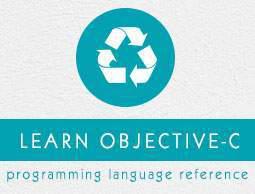Objective-C Strings
The string in Objective-C programming language is represented using NSString and its subclass NSMutableString provides several ways for creating string objects. The simplest way to create a string object is to use the Objective-C @"..." construct −
NSString *greeting = @"Hello";
A simple example for creating and printing a string is shown below.
#import <Foundation/Foundation.h>
int main () {
NSString *greeting = @"Hello";
NSLog(@"Greeting message: %@\n", greeting );
return 0;
}
When the above code is compiled and executed, it produces result something as follows −
2013-09-11 01:21:39.922 demo[23926] Greeting message: Hello
Objective-C supports a wide range of methods for manipulate strings −
| Sr.No. |
Method & Purpose |
| 1 |
- (NSString *)capitalizedString;
Returns a capitalized representation of the receiver. |
| 2 |
- (unichar)characterAtIndex:(NSUInteger)index;
Returns the character at a given array position. |
| 3 |
- (double)doubleValue;
Returns the floating-point value of the receiver’s text as a double. |
| 4 |
- (float)floatValue;
Returns the floating-point value of the receiver’s text as a float. |
| 5 |
- (BOOL)hasPrefix:(NSString *)aString;
Returns a Boolean value that indicates whether a given string matches the beginning characters of the receiver. |
| 6 |
- (BOOL)hasSuffix:(NSString *)aString;
Returns a Boolean value that indicates whether a given string matches the ending characters of the receiver. |
| 7 |
- (id)initWithFormat:(NSString *)format ...;
Returns an NSString object initialized by using a given format string as a template into which the remaining argument values are substituted. |
| 8 |
- (NSInteger)integerValue;
Returns the NSInteger value of the receiver’s text. |
| 9 |
- (BOOL)isEqualToString:(NSString *)aString;
Returns a Boolean value that indicates whether a given string is equal to the receiver using a literal Unicode-based comparison. |
| 10 |
- (NSUInteger)length;
Returns the number of Unicode characters in the receiver. |
| 11 |
- (NSString *)lowercaseString;
Returns lowercased representation of the receiver. |
| 12 |
- (NSRange)rangeOfString:(NSString *)aString;
Finds and returns the range of the first occurrence of a given string within the receiver. |
| 13 |
- (NSString *)stringByAppendingFormat:(NSString *)format ...;
Returns a string made by appending to the receiver a string constructed from a given format string and the following arguments. |
| 14 |
- (NSString *)stringByTrimmingCharactersInSet:(NSCharacterSet *)set;
Returns a new string made by removing from both ends of the receiver characters contained in a given character set. |
| 15 |
- (NSString *)substringFromIndex:(NSUInteger)anIndex;
Returns a new string containing the characters of the receiver from the one at a given index to the end. |
Following example makes use of few of the above-mentioned functions −
#import <Foundation/Foundation.h>
int main () {
NSString *str1 = @"Hello";
NSString *str2 = @"World";
NSString *str3;
int len ;
NSAutoreleasePool * pool = [[NSAutoreleasePool alloc] init];
/* uppercase string */
str3 = [str2 uppercaseString];
NSLog(@"Uppercase String : %@\n", str3 );
/* concatenates str1 and str2 */
str3 = [str1 stringByAppendingFormat:@"World"];
NSLog(@"Concatenated string: %@\n", str3 );
/* total length of str3 after concatenation */
len = [str3 length];
NSLog(@"Length of Str3 : %d\n", len );
/* InitWithFormat */
str3 = [[NSString alloc] initWithFormat:@"%@ %@",str1,str2];
NSLog(@"Using initWithFormat: %@\n", str3 );
[pool drain];
return 0;
}
When the above code is compiled and executed, it produces result something as follows −
2013-09-11 01:15:45.069 demo[30378] Uppercase String : WORLD
2013-09-11 01:15:45.070 demo[30378] Concatenated string: HelloWorld
2013-09-11 01:15:45.070 demo[30378] Length of Str3 : 10
2013-09-11 01:15:45.070 demo[30378] Using initWithFormat: Hello World
You can find a complete list of Objective-C NSString related methods in NSString Class Reference.


